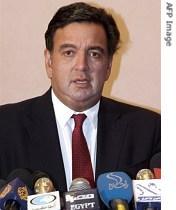2007年VOA标准英语-Less Known US Presidential Candidates Struggle(在线收听)
Washington
09 April 2007
The latest tally of those either running for U.S. president or thinking about it now stands at about 20. Some are well known, like Hillary Clinton and John McCain. Others are more obscure. VOA National Correspondent Jim Malone has more from Washington.
Among the 10 candidates seeking the Republican Party's presidential nomination next year, you may have missed this announcement by one of the latest to join the race.
"Hi, I am Tom Tancredo and I am today announcing my candidacy for President of the United States," he said.
Tancredo is a Republican congressman from Colorado who is basing his White House bid on one single issue.
"I am doing so on talk radio because we face a problem of enormous proportion, and it is called illegal immigration," said Tom Tancredo.
Political experts give Tancredo and other so-called marginal candidates little chance of winning the Republican nomination. Others include California Congressman Duncan Hunter, Texas Congressman Ron Paul and former Virginia Governor Jim Gilmore.
Democrats have their share of contenders struggling for attention in a presidential field that includes such well-known candidates as Hillary Clinton, Barack Obama and John Edwards. Former Alaska Senator Mike Gravel and Ohio Congressman Dennis Kucinich are rarely mentioned in news stories about the campaign.
 |
| Bill Richardson |
Richardson is basing his appeal to Democrats in part on his tenure as President Clinton's Ambassador to the United Nations and often takes aim at President Bush's record on foreign policy.
"I know the usual rap [critique] on governors, that we do not know anything about foreign policy," said Bill Richardson. "Well, maybe you can say that about a certain [former] governor from Texas [President Bush], but not this governor."
So why are so many candidates with apparently little chance of winning staying in the race? Rutgers University expert Ross Baker says many of them are hoping to get a second look if and when some of the better known candidates stumble on the campaign trail.
"The people who are very prominent now and appear to be the potential winners, they can fade and people can lose interest in them," he said. "Their campaigns may falter. You know, the longer the campaign, the greater the likelihood of somebody making a slip."
Recent campaign fundraising totals suggest the lesser known candidates will have a steep hill to climb to be taken seriously in the presidential race. Democrats Clinton and Obama each raised more than $25 million while Republican Mitt Romney collected $21 million in the first three months of this year.
That compares with the $500,000 each raised by Republican candidates Duncan Hunter and Mike Huckabee.
John Fortier monitors U.S. politics at the American Enterprise Institute in Washington.
"Raising money is very important for practical reasons such as running ads," he said. "But it also becomes a symbol of your strength."
Despite the large field of candidates, there is a possibility that other contenders could yet join the presidential race, including Former Republican Senator Fred Thompson and former Speaker of the House (of Representatives) Newt Gingrich.
Rutgers expert Ross Baker says the high cost of campaigning could make that difficult.
"I think the principal obstacle to late entrants into the campaign is money," he said. "These are enormously expensive campaigns to run. I mean, $100 million is not an outrageous amount to talk about in the case of an individual campaign, and that is the problem."
Because of the large number of candidates, both parties can look forward to some very crowded public debates in the months before the first presidential caucuses and primaries next January.